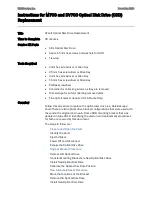
Chapter 1: System Description
DXi Advanced Reporting
Quantum DXi4700 User’s Guide
29
1 - HDD Slot 0
4 - HDD Slot 3
7 - HDD Slot 6
10 - HDD Slot 9
2 - HDD Slot 1
5 - HDD Slot 4
8 - HDD Slot 7
11 - HDD Slot 10
3 - HDD Slot 2
6 - HDD Slot 5
9 - HDD Slot 8
12 - HDD Slot 11
Figure 14:
DXi4700 G2 Expansion Module RAID Sets
1
2
3
4
5
6
7
8
9
10
11
12
0
1
2
3
4
5
6
7
8
9
10
11
1 - HDD Slot 0
4 - HDD Slot 3
7 - HDD Slot 6
10 - HDD Slot 9
2 - HDD Slot 1
5 - HDD Slot 4
8 - HDD Slot 7
11 - HDD Slot 10
3 - HDD Slot 2
6 - HDD Slot 5
9 - HDD Slot 8
12 - HDD Slot 11
DXi Advanced Reporting
Quantum DXi Advanced Reporting works with all DXi-Series disk backup systems. DXi Advanced
Reporting combines comprehensive performance data logging with powerful visual reporting and analysis
tools to help you identify potential problems and optimize system operation. For more information, refer to
the
DXi Advanced Reporting User’s Guide
(6-67353).
Network Configuration
During network configuration, each individual interface on the DXi4700 can be configured as a subnet with
its own network settings. Each physical Ethernet port can be configured as an interface. In addition, you can
also create bonded interfaces (logical ports) consisting of two or more physical ports.
Keep in mind that any traffic can pass through any of the configured Ethernet ports. This means that the
routing of different traffic types, as well as firewall capability, must be controlled using the network
infrastructure (routers and switches) connected to the DXi4700.
For more information about configuration network settings, see
.
Note:
Each configured network interface requires its own set of network settings (IP address, network
mask, and gateway).
















































